亚丁湾中尺度涡旋的生命周期
IF 1.1
4区 地球科学
Q3 ASTRONOMY & ASTROPHYSICS
Geophysical and Astrophysical Fluid Dynamics
Pub Date : 2020-01-15
DOI:10.1080/03091929.2019.1708348
引用次数: 8
摘要
红海水是由强烈的太阳辐射引起的蒸发在红海中产生的一种温暖的咸水。这种密集的水团通过曼德海峡从红海流出,并以密度流的形式进入亚丁湾,深度在400到1000米之间。在亚丁湾,实地观测和卫星观测表明,影响深远的涡流主导着中尺度动力学,对红海水的扩散产生了影响。本文采用中尺度分辨率的区域原始方程模型和涡旋跟踪算法研究了亚丁湾这些中尺度涡旋的生命周期。中尺度反气旋涡旋在亚丁湾入口处形成,随后向西漂移进入亚丁湾。中尺度反气旋比气旋寿命长。气旋是反气旋与海岸和斜坡地形相互作用的结果。风应力、水深和周围涡场驱动涡的生命周期。最后,开尔文波和内波沿着南北海岸被触发。本文章由计算机程序翻译,如有差异,请以英文原文为准。
Life cycle of mesoscale eddies in the Gulf of Aden
The Red Sea Water is a warm and salty water produced in the Red Sea by evaporation induced by strong solar radiation. This dense water mass exits the Red Sea through the Strait of Bab El Mandeb, and enters the Gulf of Aden as a density current between 400 and 1000 metre depth. In the Gulf of Aden, in situ and satellites observations have shown the impact of the deeply reaching eddies dominating the mesoscale dynamics, on the spreading of the Red Sea Water. In this paper, we study the life cycle of these mesoscale eddies in the Gulf of Aden by using a regional primitive equation model at mesoscale resolution, and an eddy-tracking algorithm. The mesoscale anticyclonic eddies are formed at the mouth of the Gulf of Aden, and subsequently drift westward into the gulf. Mesoscale anticyclones are long-lived compared to the cyclones. The cyclones result from the interaction of anticyclones with the coast and the sloping topography. The wind stress, the bathymetry and the surrounding eddy field drive the life cycle of eddies. Finally, Kelvin and internal waves are triggered along the northern and southern coasts.
求助全文
通过发布文献求助,成功后即可免费获取论文全文。
去求助
来源期刊

Geophysical and Astrophysical Fluid Dynamics
地学天文-地球化学与地球物理
CiteScore
3.10
自引率
0.00%
发文量
14
审稿时长
>12 weeks
期刊介绍:
Geophysical and Astrophysical Fluid Dynamics exists for the publication of original research papers and short communications, occasional survey articles and conference reports on the fluid mechanics of the earth and planets, including oceans, atmospheres and interiors, and the fluid mechanics of the sun, stars and other astrophysical objects.
In addition, their magnetohydrodynamic behaviours are investigated. Experimental, theoretical and numerical studies of rotating, stratified and convecting fluids of general interest to geophysicists and astrophysicists appear. Properly interpreted observational results are also published.
 求助内容:
求助内容: 应助结果提醒方式:
应助结果提醒方式:


